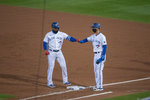 Severna Park
Severna ParkPartly Cloudy, 57°
Wind: 8.1 mph, N
 Severna Park
Severna Park


Fifteen years.
It had been 15 years since Toronto Blue Jays first base coach Mark Budzinski had stepped foot in Sahlen Field, home of the Buffalo Bisons, the Blue Jays Triple-A minor league affiliate.
For the Severna Park-born Budzinski, that first glimpse aroused flashbacks of his time as a player with the Bisons in 2001, when they were affiliated with the Cleveland Indians.
“It was actually pretty cool,” Budzinski said. “Our coaches’ locker room was in the home clubhouse. Where I had a locker then, I was standing where the sinks are in the bathroom, just outside of the locker room, and just reflecting back 20 years almost. It was surreal.”
The Blue Jays were forced to move there after the Canadian government prevented them from playing in Rogers Centre, their home ballpark, for the 2020 Major League Baseball season.
Sahlen, after hoping to attract an MLB team when it opened in 1988, now had its time in the spotlight, a stadium now situated between office buildings, a parking garage outside left field, and the on-ramp to I-190 in right.
The year 2020 has provided anything but a sense of normalcy for most around the world, but despite that, for baseball fans, this felt strangely normal.
What didn’t feel normal was games being played in front of no fans, just empty seats, or for some teams, cardboard cutouts or even stuffed animals, with artificial crowd noise pumped in through the stadium speaker systems.
“It was a lot different not having real fans and the energy they bring,” Milwaukee Brewers closer and Old Mill High School alum Josh Hader said. “However, once you were in the game, you were focusing on competing.”
This is just a snapshot of MLB in the era of the COVID-19 pandemic, something that started in March with the suspension of the 2020 season.
It persisted through the late spring and early summer, with back-and-forth arguments between the players and owners, and then an agreement on a 60-game regular season and 16-team expanded playoff format.
After the MLB’s initial announcement on March 12 at 4:00pm EST, no one truly expected the shutdown to last four months.
“We had no idea how long it was going to last,” Budzinski said. “I think when we left Florida, we were thinking three weeks to a month. When it got past that point, we had no idea.”
Budzinski left the Blue Jays spring training facilities in Dunedin, Florida, to return to family and his home in Richmond, Virginia, and the team went online, meeting on Zoom, texting or calling each other as quarantine went on.
On the other side of the country, Hader was able to utilize the Brewers’ spring training facilities in Phoenix, Arizona, at least for a few months.
“It started to shut down everyone,” Hader said. “We were able to work out at the complex through some of the months. Once we shut down, I had a net that I would throw into.”
Once MLB announced its season in June and subsequent spring training 2.0, or summer camp as MLB branded it, which began on July 1, things kicked into high gear. Teams trained at their respective ballparks, including the Blue Jays in Toronto, but anyone who left the confines of the Rogers Centre during summer camp faced a $750,000 fine.
“Our front office did a great job just setting us up in a position to succeed there and to stay healthy,” Budzinski said.
Workouts were limited to a certain percentage of players, COVID testing was done every other day or several times a week, and meals were pre-prepared and put in to-go boxes, and the latter two continued into the regular season.
While summer camp was held in 30 separate bubbles, the regular season wasn’t, though schedules were modified to reduce travel, as teams faced same-division opponents in their league and the opposite league.
Home or road, the routine was pretty much the same, including wearing masks everywhere even on the basepaths, in the dugout and in the clubhouse.
“Most of us lived in a hotel,” Budzinski said. “In Buffalo, there were a few guys who had residence there, but it was basically from the hotel to the ballpark and back. Same thing on the road. There was no going into restaurants. There was no going into malls or stores.”
That business-like mentality persisted throughout the league in a season where more than ever, every series was important for a playoff push.
The Blue Jays, despite the stadium switch, and the Brewers, both made it to the postseason, clinching the No. 8 seed in their respective leagues, but were subsequently knocked out in the Wild Card series, losing 2-0 to the Tampa Bay Rays and Los Angeles Dodgers, respectively.
Postseason celebrations were different, as were post-game celebrations, with an emphasis on elbow-bumping instead of high-fives, and no champagne showers, but the achievement of getting there didn’t change.
The Rays and Dodgers battled in the World Series in Arlington, Texas, in front of reduced-capacity crowds, the final step in MLB’s modified postseason bubble, with the Dodgers earning their first world title since 1988 with a 3-1 victory on October 27.
Moving forward, nothing will truly come close to replicating the 2020 MLB season.
“It’s a season I’ll remember for a long time,” Hader said.
Other items that may interest you
Comments
No comments on this item Please log in to comment by clicking here